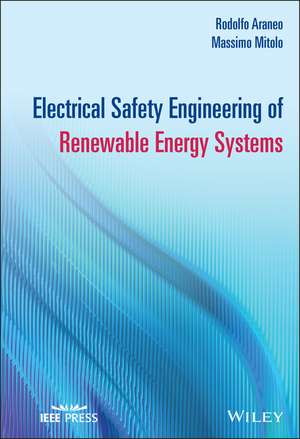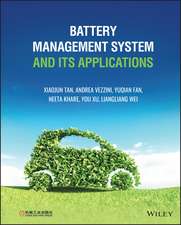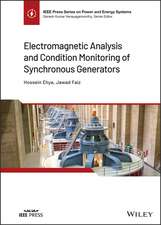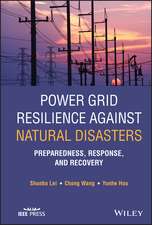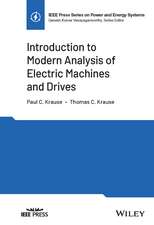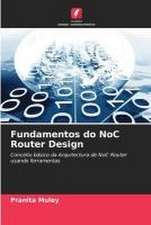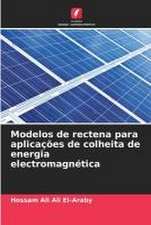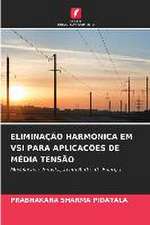Electrical Safety Engineering of Renewable Energy Systems: IEEE Press
Autor R Araneoen Limba Engleză Hardback – 28 oct 2021
Electrical Safety Engineering of Renewable Energy Systems is an authoritative text that offers an in-depth exploration to the safety challenges of renewable systems. The authors--noted experts on the topic--cover a wide-range of renewable systems including photovoltaic, wind, and cogeneration and propose a safety-by-design approach. The book clearly illustrates safe behavior in complex real-world renewable energy systems using practical approaches.
The book contains a review of the foundational electrical engineering topics and highlights how safety engineering links to the renewable energies. Designed as an accessible resource, the text discusses the most relevant and current topics supported by rigorous analytical, theoretical and numerical analyses. The authors also provide guidelines for readers interested in practical applications. This important book:
- Reviews of the major electrical engineering topics
- Shows how safety engineering links to the renewable energies
- Discusses the most relevant current topics in the field
- Provides solid theoretical and numerical explanations
Din seria IEEE Press
- 5%
 Preț: 599.39 lei
Preț: 599.39 lei - 50%
 Preț: 402.61 lei
Preț: 402.61 lei - 14%
 Preț: 743.46 lei
Preț: 743.46 lei - 24%
 Preț: 600.44 lei
Preț: 600.44 lei - 24%
 Preț: 1226.90 lei
Preț: 1226.90 lei - 24%
 Preț: 667.14 lei
Preț: 667.14 lei - 24%
 Preț: 672.03 lei
Preț: 672.03 lei - 24%
 Preț: 741.52 lei
Preț: 741.52 lei - 24%
 Preț: 546.23 lei
Preț: 546.23 lei - 24%
 Preț: 572.09 lei
Preț: 572.09 lei - 24%
 Preț: 706.11 lei
Preț: 706.11 lei - 24%
 Preț: 618.96 lei
Preț: 618.96 lei - 24%
 Preț: 704.87 lei
Preț: 704.87 lei - 24%
 Preț: 702.62 lei
Preț: 702.62 lei - 24%
 Preț: 617.44 lei
Preț: 617.44 lei - 24%
 Preț: 612.64 lei
Preț: 612.64 lei - 20%
 Preț: 446.57 lei
Preț: 446.57 lei - 24%
 Preț: 707.87 lei
Preț: 707.87 lei - 24%
 Preț: 695.85 lei
Preț: 695.85 lei - 14%
 Preț: 858.78 lei
Preț: 858.78 lei -
 Preț: 415.98 lei
Preț: 415.98 lei - 9%
 Preț: 1010.21 lei
Preț: 1010.21 lei - 9%
 Preț: 1499.89 lei
Preț: 1499.89 lei - 9%
 Preț: 806.07 lei
Preț: 806.07 lei - 9%
 Preț: 1069.47 lei
Preț: 1069.47 lei - 9%
 Preț: 1485.82 lei
Preț: 1485.82 lei - 9%
 Preț: 1020.25 lei
Preț: 1020.25 lei - 9%
 Preț: 930.31 lei
Preț: 930.31 lei - 9%
 Preț: 1117.45 lei
Preț: 1117.45 lei - 20%
 Preț: 723.20 lei
Preț: 723.20 lei - 9%
 Preț: 923.82 lei
Preț: 923.82 lei - 9%
 Preț: 994.01 lei
Preț: 994.01 lei - 9%
 Preț: 963.51 lei
Preț: 963.51 lei - 9%
 Preț: 1969.97 lei
Preț: 1969.97 lei - 9%
 Preț: 742.90 lei
Preț: 742.90 lei - 9%
 Preț: 1021.22 lei
Preț: 1021.22 lei - 9%
 Preț: 997.70 lei
Preț: 997.70 lei - 9%
 Preț: 970.56 lei
Preț: 970.56 lei - 9%
 Preț: 781.15 lei
Preț: 781.15 lei - 9%
 Preț: 1162.23 lei
Preț: 1162.23 lei - 9%
 Preț: 1030.34 lei
Preț: 1030.34 lei - 9%
 Preț: 815.85 lei
Preț: 815.85 lei - 9%
 Preț: 1130.31 lei
Preț: 1130.31 lei - 9%
 Preț: 1560.74 lei
Preț: 1560.74 lei - 9%
 Preț: 1289.30 lei
Preț: 1289.30 lei - 9%
 Preț: 1036.75 lei
Preț: 1036.75 lei - 9%
 Preț: 968.96 lei
Preț: 968.96 lei - 9%
 Preț: 1130.63 lei
Preț: 1130.63 lei - 9%
 Preț: 1010.82 lei
Preț: 1010.82 lei - 9%
 Preț: 1237.02 lei
Preț: 1237.02 lei
Preț: 810.87 lei
Preț vechi: 891.07 lei
-9% Nou
Puncte Express: 1216
Preț estimativ în valută:
155.20€ • 161.41$ • 130.06£
155.20€ • 161.41$ • 130.06£
Carte tipărită la comandă
Livrare economică 13-27 martie
Preluare comenzi: 021 569.72.76
Specificații
ISBN-13: 9781119624981
ISBN-10: 1119624983
Pagini: 304
Dimensiuni: 150 x 255 x 22 mm
Greutate: 0.57 kg
Editura: Wiley
Seria IEEE Press
Locul publicării:Hoboken, United States
ISBN-10: 1119624983
Pagini: 304
Dimensiuni: 150 x 255 x 22 mm
Greutate: 0.57 kg
Editura: Wiley
Seria IEEE Press
Locul publicării:Hoboken, United States
Cuprins
Preface ix
Acknowledgments xi
1 Fundamental Concepts of Electrical Safety Engineering 1
1.1 Introduction 1
1.2 Electric Shock 2
1.2.1 Ventricular Fibrillation 3
1.2.2 The Heart-current Factor 5
1.3 The Electrical Impedance of the Human Body 6
1.3.1 The Internal Resistance of the Human Body 7
1.4 Thermal Shock 10
1.5 Heated Surfaces of Electrical Equipment and Contact Burn Injuries 12
1.6 Ground-Potential and Ground-Resistance 14
1.6.1 Area of Influence of a Ground-electrode 18
1.7 Hemispherical Electrodes in Parallel 18
1.8 Hemispherical Electrodes in Series 19
1.9 Person's Body Resistance-to-ground and Touch Voltages 20
1.10 Identification of Extraneous-Conductive-Parts 24
1.11 Measuring Touch Voltages 26
2 Safety-by-Design Approach in AC/DC Systems 31
2.1 Introduction 31
2.2 Class I PV Equipment 33
2.3 Class II PV Equipment 35
2.4 Ground Faults and Ground Fault Protection 35
2.5 Functionally Grounded PV Systems 37
2.6 Non-Ground-Referenced PV Systems 40
2.7 Ground-Referenced PV Systems 42
2.8 Fire Hazard in Ground-Referenced PV Systems 44
2.9 Faults at Loads Downstream the PV Inverter in Ground-Referenced PV Systems 47
2.10 Non-Electrically Separated PV System 48
2.11 PV Systems Wiring Methods and Safety 50
2.12 d.c. Currents and Safety 52
2.13 Electrical Safety of PV Systems 55
2.14 Rapid-Shutdown of PV Arrays on Buildings 57
2.15 Hazard and Risk 58
3 Grounding and Bonding 63
3.1 Introduction 63
3.2 Basic Concepts of Grounding Systems: The Ground Rod 67
3.3 The Maxwell Method 77
3.4 Multiple Rods: Mutual Resistance 83
3.5 Ground Rings and Ground Grid 87
3.6 Complex Arrangements: Rings and Ground Grids Combined with Rods and Horizontal Electrodes 100
4 Lightning Protection Systems 107
4.1 Review of Natural Lightning Physics, Modeling and Protection 108
4.2 Lightning Protection of PV Systems 121
4.2.1 Ground-Mounted PV Systems 124
4.2.2 Rooftop Mounted PV Systems 126
4.2.3 Protection against Overvoltage 128
4.2.4 Surge Protective Devices (SPDs) 130
4.3 Lighting Protection of Wind Turbines 136
4.3.1 Lightning Protection System (LPS) 139
4.3.2 Step and Touch Voltages 143
4.3.3 Lightning Exposure Assessment 144
4.3.4 Assessment of the Average Annual Number of Dangerous Events NL Due to Flashes Directly to and near Service Cables 147
4.3.5 Lightning Protection Zones 149
4.4 High-Frequency Grounding Systems 151
4.4.1 Arrangement of Ground Electrodes 155
4.4.2 Effective Length of a Ground Electrode 157
4.4.3 Frequency-dependent Soil and Ionization 158
5 Renewable Energy System Protection and Coordination 169
5.1 Introduction 169
5.2 Power Collection Systems 170
5.3 Cable Connections 182
5.4 Offshore Wind Farm 188
5.5 Distributed Energy Resources: Battery Energy Storage Systems and Electric Vehicles 192
6 Soil Resistivity Measurements and Ground Resistance 205
6.1 Soil Resistivity Measurements 205
6.2 Wenner Method 208
6.3 Schlumberger Method 214
6.4 Multi-layer Soils 214
6.4.1 Ground Grid in Multi-layer Soil 217
6.4.2 Ground Rod in Multi-layer Soil 219
6.5 Fall-of-Potential Method for Ground Resistance Measurement 220
6.6 Slope Method for Grounding Resistance Measurement 223
6.7 Star-delta Method for Grounding Resistance Measurement 224
6.8 Four Potential Method for Grounding Resistance Measurement 225
6.9 Potentiometer Method for Grounding Resistance Measurement 226
Appendix 1: Performance of Grounding Systems in Transient Conditions 231
1 Grounding System Analysis 232
2 Mathematical Model 233
3 Computation of Impedances 235
4 Green's Function 237
4.1 Static Formulation 237
4.1.1 One-Layer Ground 242
4.1.2 Two-Layer Ground 243
4.2 Dynamic Formulation 245
4.2.1 Equivalent Transmission Line Approach 249
5 Numerical Integration Aspects 252
5.1 Singular Term 252
5.2 Sommerfeld Integrals 254
Appendix 2: Cable Failures in Renewable Energy Systems 265
1 Cable Failures in Renewable Energy Systems: Introduction 266
2 Possible Solutions 267
2.1 Optimal Solutions 268
2.2 Termite Attacks Prevention 269
3 Non-destructive Methods for Cable Testing and Fault-locating 269
3.1 Insulation Resistance (IR) Test 271
3.1.1 IR Measurement of the Cable Insulation (XLPE) 271
3.1.2 IR Measurement of the Polyethylene (PE) Cable Jacket 272
3.2 High-Potential Test 272
3.3 LCR Test 273
3.3.1 Insulation Resistance (IR) 273
3.3.2 Dielectric Absorption Ratio (DAR) 273
3.3.3 Polarization Index (PI) 274
3.3.4 Quality Factor (Q) 274
3.3.5 Dissipation Factor (DF) 274
3.3.6 Time Domain Reflectometry (TDR) Test 275
3.3.7 Arc Reflection (ARC) Test 276
3.3.8 Bridge Methods 276
3.4 Cable Fault Analysis 279
3.4.1 Prelocation 279
3.4.2 Pinpointing 280
4 Sheath and Jacket Repairs 280
5 Termite Baiting Stations and Monitoring 281
6 Termite-proof Cables 283
Index 28
